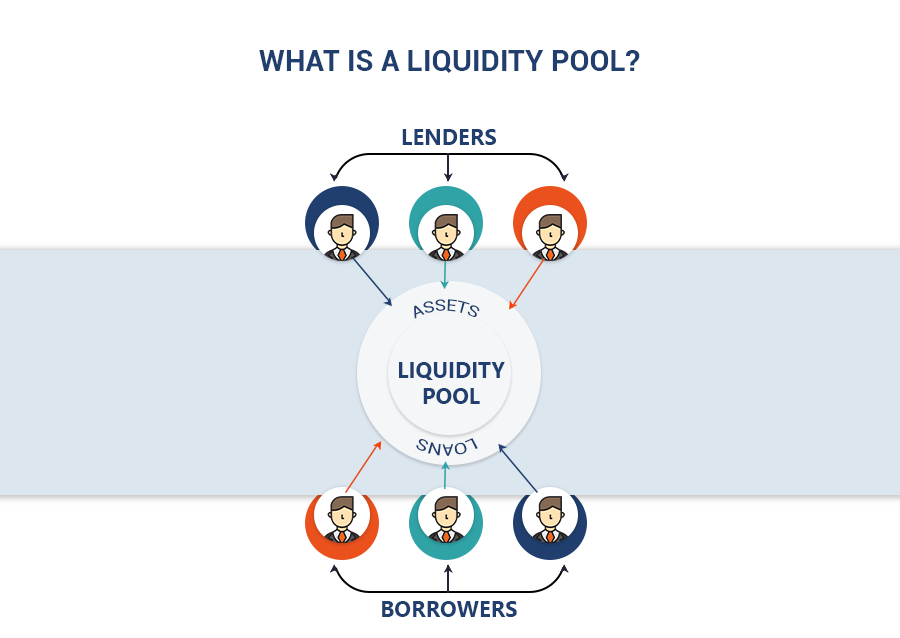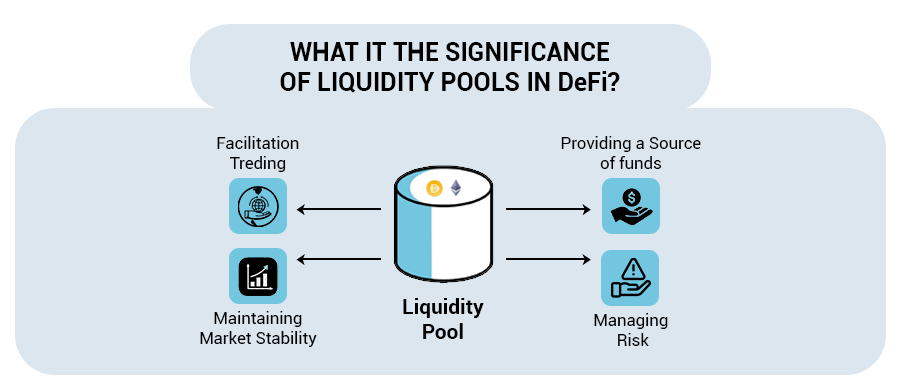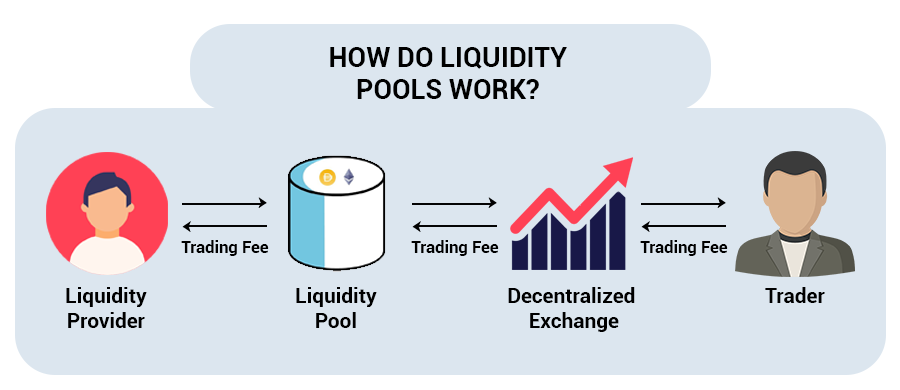Hey there! Ever dabbled in decentralized finance (DeFi) and heard folks chattering about “liquidity pool”? It’s not as complicated as it sounds.
So, what is a liquidity pool exactly? Imagine a giant pool of funds, but instead of water, it’s filled with tokens contributed by people just like you and me. That, in essence, is a liquidity pool!
But why does it matter? Well, these pools play a crucial role in automated market maker (AMM) protocols. They help to combat liquidity issues, making sure trades on decentralized exchanges happen without a hitch.
If you’re picturing a liquidity pool as just a fancy place where tokens go for a dip, you’re not entirely wrong. But, believe me, there’s so much more to explore beneath the surface.
Ready to deep-dive into the fascinating universe of liquidity pools and discover how they’re shaping the DeFi landscape? Buckle up, because we’re about to plunge right in!
Contents
What is a Liquidity Pool?

A liquidity pool refers to a pool of funds locked in a smart contract on a decentralized finance (DeFi) platform. Liquidity pools enable users to provide liquidity by depositing their digital assets into the pool, which is then used to facilitate trading or lending activities within the platform.
In a traditional financial market, liquidity is provided by centralized intermediaries like banks. However, in the decentralized world of cryptocurrencies and DeFi, liquidity pools serve as an alternative mechanism to ensure sufficient liquidity for various financial activities.
Liquidity pools typically operate on automated market maker (AMM) protocols, which use algorithms to determine the price of assets based on the supply and demand within the pool.
The most common AMM algorithm is called constant product, which ensures that the product of the quantities of two assets in the pool remains constant, allowing for price adjustments based on trading volume.
Participants in a liquidity pool earn returns in the form of fees generated from trades or loans within the platform. These fees are typically shared among the liquidity providers proportional to their share of the pool.
By providing liquidity to a pool, individuals can earn passive income on their assets while facilitating trading and lending activities for other users.
Liquidity pools have become a fundamental building block of decentralized finance, providing liquidity for decentralized exchanges (DEXs), lending platforms, and other DeFi applications. They enhance market efficiency, reduce slippage, and enable greater accessibility to financial services in the decentralized ecosystem.
What is the Significance of Liquidity Pools in DeFi?

Liquidity pools play a significant role in decentralized finance (DeFi) by enhancing market efficiency and reducing slippage. In traditional financial markets, liquidity is provided by centralized intermediaries, but DeFi liquidity pools allow users to contribute their assets directly.
This decentralized liquidity provision eliminates the need for intermediaries and enables faster, more efficient transactions. By providing deeper liquidity, these pools reduce slippage, ensuring that trades can be executed at more favorable prices.
Furthermore, liquidity pools promote accessibility and inclusivity in the DeFi ecosystem. Users can participate in trading, lending, and other financial activities without relying on a centralized authority. This opens up opportunities for a wider range of individuals, including those who may not have access to traditional financial services.
Additionally, liquidity providers earn passive income through fees generated by the DeFi platform. By contributing assets to a liquidity pool, users can earn returns on their holdings without actively trading.
Liquidity pools have also sparked innovation in DeFi, serving as the foundation for decentralized exchanges, lending protocols, yield farming platforms, and more. These pools enable the creation of new financial products and services that leverage the decentralized nature of blockchain technology.
In terms of transparency and security, DeFi liquidity pools operate on blockchain networks, ensuring transparency and immutability. Transactions within the pools are recorded on the blockchain, enhancing trust among participants.
What are the Advantages of Liquidity Pools?
Liquidity pools offer several advantages in the realm of decentralized finance (DeFi):
- Increased liquidity: Liquidity pools provide readily tradable assets, improving liquidity and reducing slippage.
- Market efficiency: By eliminating intermediaries, liquidity pools enable direct peer-to-peer transactions, resulting in faster and more efficient trades.
- Accessibility: Anyone can participate as a liquidity provider with small amounts of capital, promoting financial inclusivity in DeFi.
- Passive income generation: Liquidity providers earn fees without active trading, generating passive income on their assets.
- Flexibility and diversification: Liquidity pools support various asset pairs, allowing users to diversify their holdings and allocate assets based on their preferences.
- Innovation and yield opportunities: Liquidity pools serve as the foundation for innovative DeFi applications and yield farming, offering additional rewards and optimization possibilities.
- Transparency and security: Liquidity pools operate on blockchain networks, ensuring transparency, immutability, and verifiability of transactions for enhanced trust.
Why are Liquidity Pools Important?
Liquidity pools play a vital role in decentralized finance (DeFi) due to their significant impact on market efficiency, accessibility, and stability.
Market Efficiency
Liquidity pools enhance market efficiency by ensuring a sufficient supply of assets for trading and lending in the DeFi ecosystem. They help reduce slippage, the difference between the expected and executed prices of assets, allowing traders to execute transactions more accurately at fair prices.
Financial Inclusion
They democratize access to financial services by allowing anyone to participate as a liquidity provider, not just those with access to traditional financial services or significant capital. Users can contribute assets and earn passive income from the platform fees, making financial opportunities more accessible.
Stability and Price Formation
Liquidity pools contribute to stability within the DeFi market by providing a constant supply of assets, absorbing buying and selling pressures and reducing price volatility. This stability is beneficial for traders and investors seeking predictable price movements.
Price Discovery
They enhance price discovery by ensuring market forces determine asset prices and are not susceptible to manipulation or illiquidity.
To summarize, liquidity pools play a crucial role in DeFi. They facilitate fairer trading, enable broader participation, ensure stable asset prices, and contribute to the overall growth, accessibility, and adoption of decentralized finance.
How do Liquidity Pools Work?

Liquidity pools work by allowing users to deposit their assets into a pool, which is then used to facilitate trades or lending within a decentralized finance (DeFi) platform. Here’s a step-by-step explanation of how liquidity pools typically operate:
Creation of the Pool
A liquidity pool is created on a DeFi platform, often using a smart contract. The pool consists of two or more assets that users can deposit. For example, in a simple pool, it could be a pair of assets like Ether (ETH) and a stablecoin like USDT.
Deposit of Assets
Users who wish to provide liquidity to the pool deposit their assets in equal value proportions. For instance, if Alice wants to provide liquidity to the ETH-USDT pool, she might deposit 5 ETH and 5,000 USDT.
Pricing and Tokenization
The pool calculates the price of each asset based on the algorithm used by the automated market maker (AMM) protocol. The most common algorithm is the constant product formula (e.g., x*y=k), which maintains a constant product of the asset quantities in the pool.
Tokens representing the user’s share of the pool, known as liquidity tokens, are minted and issued to the user in return for their deposited assets. These liquidity tokens represent the user’s ownership in the pool and can be later redeemed for their proportional share.
Trading and Swapping
The liquidity pool enables users to trade assets within the platform. When a user wants to make a trade, the AMM algorithm automatically adjusts the asset prices in response to the trade.
The assets are swapped directly from the liquidity pool, and the trading fees generated are distributed to the liquidity providers.
Liquidity Provider Rewards
Liquidity providers earn rewards for supplying liquidity to the pool. These rewards usually come in the form of trading fees generated by the platform. The fees are distributed proportionally among the liquidity providers based on their share of the pool.
Providers can withdraw their share of the pooled assets, along with the earned fees, at any time.
Rebalancing
As trades occur, the liquidity pool’s asset balances can become imbalanced. To maintain price stability, liquidity providers may need to rebalance the pool by adding or removing assets. Some platforms also incentivize rebalancing by offering additional rewards.
Some Important Use Cases of Liquidity Pools You Should Know
Liquidity pools have found significant use cases in decentralized finance (DeFi), driving innovation and enabling various financial activities. Some important use cases of liquidity pools include:
Decentralized Exchanges (DEXs)
Liquidity pools serve as the backbone of DEXs, allowing users to trade assets directly with one another. By providing liquidity to these pools, users enable seamless and decentralized asset swaps, empowering individuals to trade cryptocurrencies without relying on traditional intermediaries.
Automated Market Making (AMM)
Liquidity pools are an integral part of AMM protocols used in DEXs. These protocols use algorithms to determine asset prices based on the available liquidity in the pool. Liquidity providers contribute their assets to the pool, facilitating the automated trading process and ensuring continuous user liquidity.
Lending and Borrowing
Liquidity pools enable lending and borrowing activities in DeFi lending platforms. Users can deposit their assets into a lending pool, allowing borrowers to access these funds by providing collateral. Liquidity providers earn interest on their deposited assets while borrowers can access capital without traditional credit checks.
Yield Farming
Liquidity pools are central to yield farming, a practice where users optimize their returns by strategically allocating their assets across different liquidity pools and protocols. Users can earn additional rewards by contributing assets to specific pools, often in the form of platform-specific tokens, incentivizing participation and liquidity provision.
Stablecoin Liquidity
Liquidity pools are crucial for maintaining liquidity in stablecoin markets. Stablecoins, which are cryptocurrencies pegged to a stable asset like a fiat currency, require liquidity to ensure their value remains stable. Liquidity pools provide the necessary liquidity for stablecoin trading, ensuring the stablecoins can be readily exchanged and used in DeFi applications.
Derivatives Trading
Liquidity pools can be used for trading derivatives in DeFi. By providing liquidity to derivative platforms, users enable trading derivative contracts, such as futures or options, without relying on centralized exchanges. Liquidity pools ensure there is sufficient liquidity for derivative traders to execute their trades.
Asset Price Oracles
Liquidity pools can be utilized as price oracles to provide reliable and decentralized price data. DeFi applications often require accurate and real-time price information for various assets. With their constant trading activity, liquidity pools can serve as a trusted source of price data for these applications.
Frequently Asked Questions
How do liquidity pools make money?
Liquidity pools generate revenue through fees charged on trades. When users trade against the pool, they pay a small fee, typically a percentage of the transaction. These fees are distributed among liquidity providers in proportion to their share of the pool. By participating in a pool, users can earn a portion of these fees as a form of passive income.
How liquidity pool price is calculated?
The price of assets in a liquidity pool is determined by a mathematical formula called an automated market maker (AMM). The AMM algorithm calculates the price based on the ratio of each asset’s quantity in the pool. As trades occur, the AMM adjusts the asset prices to maintain the balance between them, ensuring that the pool remains in equilibrium.
Conclusion
In closing, liquidity pools are a fundamental component of the Decentralized Finance (DeFi) sector, offering a repository of assets secured in a smart contract on a blockchain platform. These pools are driven by users who deposit their digital assets, allowing them to cater to various financial activities, such as trading and lending, in the DeFi environment.
Under the regulation of automated market maker (AMM) protocols, liquidity pools leverage specialized algorithms to manage asset prices based on supply and demand shifts within the pool. Participants receive a share of the fees generated from financial operations, proportional to their stake in the pool, making it a robust source of passive income.
Moreover, liquidity pools carry numerous benefits for the DeFi space, including improved market efficiency, minimized slippage, expanded access to financial services, flexible asset allocation, and a heightened capacity for innovation.
They foster an environment that supports liquidity and promotes price stability, thus playing an instrumental role in the evolution and mainstream adoption of DeFi. This ultimately empowers individuals to have more control over their financial dealings in a transparent, decentralized manner.
In the rapidly evolving DeFi space, understanding liquidity pools is fundamental. If you’re considering harnessing the power of DeFi and need professional assistance, reach out to us at Webisoft. Our experts can guide you through the intricacies of liquidity pools and help you leverage them effectively in your DeFi endeavors.

